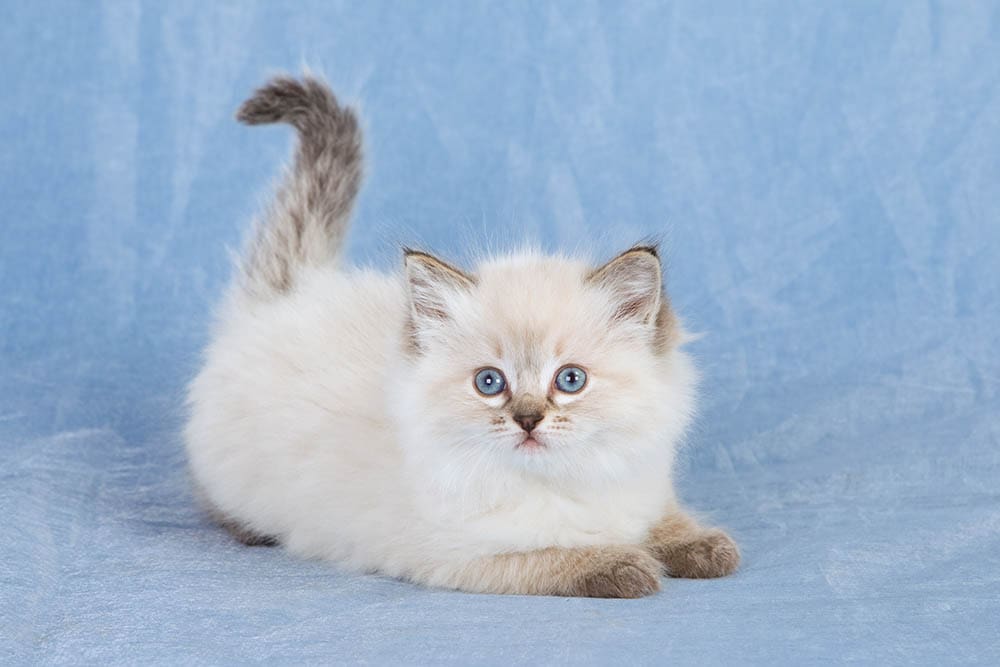
- Article published at:
- Article author: Catherine Ma
- Article tag: Articles
- Article comments count: 0
Drawer menu
With their stunning blue eyes, silky coats, and famously floppy nature, Ragdoll cats are a favourite among cat lovers in Canada and beyond. Known for their docile temperament and affectionate personality, Ragdolls are often described as the perfect indoor companion.
But what really makes the Ragdoll cat so special? In this article, we’ll explore the history, personality, appearance, health considerations, and everything you need to know before bringing a Ragdoll into your home.
The Ragdoll cat is a relatively modern breed, first developed in the 1960s by a breeder named Ann Baker in Riverside, California. The foundation cat, a long-haired white domestic cat named Josephine, produced unusually calm and affectionate kittens. Through selective breeding, Baker developed the Ragdoll breed, known for its relaxed nature and striking appearance.
The name “Ragdoll” comes from the breed’s tendency to go limp when picked up, much like a ragdoll toy. This endearing trait is now one of their most well-known characteristics.
Ragdolls were officially recognized by major cat registries like TICA and CFA in the 1990s and have been steadily growing in popularity ever since.
Looking for a gentle, affectionate cat that behaves more like a dog than a typical feline? The Ragdoll might be your perfect match.
Extremely affectionate: Ragdolls are known to follow their humans from room to room and love to be involved in everyday activities.
Calm and laid-back: They adapt well to indoor life and are not overly demanding or high-energy.
Great with kids and other pets: Their gentle nature makes them a top choice for families.
Not very vocal: They tend to communicate softly and rarely meow excessively.
Because of their relaxed temperament, Ragdolls are often described as ideal lap cats. But don’t let their chill demeanor fool you—they still love interactive play and gentle stimulation.

(Featuring my fur baby Eleven <3 )
Ragdolls are known for their large size, muscular bodies, and semi-long silky fur. They typically weigh between 10–20 pounds, with males often being larger than females.
Blue eyes: Deep blue, oval-shaped eyes are a signature of the breed.
Color-pointed coat: Similar to Siamese cats, Ragdolls have darker coloration on their ears, face, paws, and tail.
Soft, rabbit-like fur: Despite its length, their coat has minimal undercoat, making it less prone to matting.
Floppy nature: When picked up, they often go completely relaxed in your arms—just like their name suggests.

Ragdolls come in a variety of colors and patterns:
Seal (dark brown)
Blue (greyish slate)
Chocolate
Lilac
Cream
Flame (red/orange)
Colorpoint: No white markings; darker points.
Mitted: White paws, chin, and sometimes a white stripe down the belly.
Bicolour: Inverted “V” on the face, white legs and belly.
Despite these variations, all Ragdolls share that luxurious, silky coat and plush feel.

While Ragdolls are generally healthy, they are prone to a few genetic and breed-specific health issues that owners should watch for:
This is the most common heart disease in cats and can be inherited in Ragdolls. Reputable breeders screen for HCM and only breed from healthy lines.
Less common in Ragdolls, but still a concern. It causes cysts to form in the kidneys and can lead to kidney failure over time.
Some Ragdolls are more prone to UTIs, especially if not drinking enough water. A high-quality, moisture-rich diet can help.
Due to their calm nature, Ragdolls are at risk of weight gain. Regular play, portion control, and vertical climbing (like a cat tree!) are essential.
💡 Tip: Always adopt from a licensed breeder who screens for genetic diseases. Routine checkups and early detection can go a long way in keeping your Ragdoll healthy.
Ragdoll kittens are adorable fluffballs—calm, gentle, and eager to bond. However, they don’t reach full maturity until around 3–4 years old, growing slowly into their full size and coat.
If you’re considering bringing one home:
Look for ethical breeders who follow TICA or CFA standards.
Expect to pay $1,200–$2,500 CAD+ depending on lineage and quality.
Make sure your kitten has been properly socialized and vet-checked.
Adoption is also an option—some shelters and breed-specific rescues have Ragdolls available.

Ragdolls are indoor cats by nature. Their friendly temperament and low survival instinct make them ill-suited for outdoor roaming.
Make your home cozy with:
Soft bedding and hideaways
Interactive toys and puzzle feeders
Tall, stable cat trees (great for movement and lounging!)
🪴 Catopia Co. Recommends:
Our premium cat trees provide safe, vertical spaces for gentle climbers like Ragdolls—perfect for exercise, scratching, and relaxing in comfort.
👉 Shop Ragdoll-friendly Cat Trees
Adoption: $100–$300 CAD from a rescue.
Purebred kitten from a licensed breeder: $1,200–$2,500+ CAD.
Show-quality or rare colors: May be higher in price.
Always factor in costs for food, vet care, grooming, and enrichment.
The Ragdoll cat is more than just a pretty face—it's a gentle, loving, and loyal companion that thrives in a calm indoor environment. With proper care, attention to health, and a cozy home setup, your Ragdoll can be a beloved family member for 12–17+ years.
Whether you’re adopting a kitten or welcoming an adult Ragdoll, you’ll be getting one of the most affectionate and majestic cats around.
👉 Get your home Ragdoll-ready with stylish, cozy cat trees from Catopia Co.